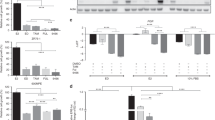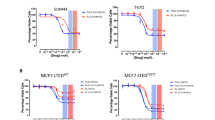Abstract
Purpose
Selective estrogen receptor degrader (SERD) has proven clinically effective in treating advanced or metastatic breast cancer since the approval of fulvestrant by FDA in 2002. Recent expansion of indications as a first line monotherapy and as combination therapy with CDK4/6 inhibitors further extends its clinical utility as an efficacious breast cancer endocrine regimen. However, the poor pharmacokinetic properties of fulvestrant and its injection-only administration route has driven continued efforts to develop orally bioavailability SERD that could potentially improve clinical response to SERD treatment. GLL398, a boron-modified GW5638 analog, showed superior oral bioavailability, while retaining both antiestrogenic activity and ER degrading efficacy at a potency level comparable to the more active metabolite of GW5638, GW7604.
Methods
Here we used molecular modeling, ER (Y537S) binding assay, MCF-7 Xenograft tumor, and patient-derived xenograft (PDX) tumor model to conduct further studies on the pharmacology and metabolism of GLL398.
Results
Consistent with GLL398's robust activities in breast cancer cells that either are tamoxifen resistant or express constitutively active, mutant ESR1 (Y537S), it was found to bind the mutant ERY537S with high affinity. Molecular modeling of the binding mode of GLL398 to ER also found its molecular interactions consistent with the experimentally determined high binding affinity towards WT ER and ERY537S. To test the in vivo efficacy of GLL398, mice bearing MCF-7-derived xenograft breast tumors and patient-derived xenograft tumors harboring ERY537S were treated with GLL398 which potently inhibited tumor growth in mice.
Conclusions
This study demonstrates GLL398 is an oral SERD that has therapeutic efficacy in clinically relevant breast tumor models.






Similar content being viewed by others
References
Bross PF, Cohen MH, Williams GA, Pazdur R (2002) FDA drug approval summaries: fulvestrant. Oncologist 7:477–480
Howell A, Sapunar F (2011) Fulvestrant revisited: efficacy and safety of the 500-mg dose. Clin Breast Cancer 11:204–210
DeFriend DJ, Howell A, Nicholson RI, Anderson E, Dowsett M et al (1994) Investigation of a new pure antiestrogen (ICI 182780) in women with primary breast cancer. Cancer Res 54:408–414
Jones SE, Pippen J (2005) Effectiveness and tolerability of fulvestrant in postmenopausal women with hormone receptor-positive breast cancer. Clin Breast Cancer 6(Suppl 1):S9–14
Robertson JF, Lindemann J, Garnett S, Anderson E, Nicholson RI et al (2014) A good drug made better: the fulvestrant dose-response story. Clin Breast Cancer 14:381–389
Di Leo A, Jerusalem G, Petruzelka L, Torres R, Bondarenko IN et al (2010) Results of the CONFIRM phase III trial comparing fulvestrant 250 mg with fulvestrant 500 mg in postmenopausal women with estrogen receptor-positive advanced breast cancer. J Clin Oncol 28:4594–4600
Di Leo A, Jerusalem G, Petruzelka L, Torres R, Bondarenko IN et al (2014) Final overall survival: fulvestrant 500 mg vs 250 mg in the randomized CONFIRM trial. J Natl Cancer Inst 106:djt337
Howell A, DeFriend DJ, Robertson JF, Blamey RW, Anderson L et al (1996) Pharmacokinetics, pharmacological and anti-tumour effects of the specific anti-oestrogen ICI 182780 in women with advanced breast cancer. Br J Cancer 74:300–308
Robertson JF, Harrison M (2004) Fulvestrant: pharmacokinetics and pharmacology. Br J Cancer 90(Suppl 1):S7–10
Pritchard KI, Rolski J, Papai Z, Mauriac L, Cardoso F et al (2010) Results of a phase II study comparing three dosing regimens of fulvestrant in postmenopausal women with advanced breast cancer (FINDER2). Breast Cancer Res Treat 123:453–461
McCormack P, Sapunar F (2008) Pharmacokinetic profile of the fulvestrant loading dose regimen in postmenopausal women with hormone receptor-positive advanced breast cancer. Clin Breast Cancer 8:347–351
Robertson JF (2007) Fulvestrant (Faslodex)—how to make a good drug better. Oncologist 12:774–784
McDonnell DP, Wardell SE, Norris JD (2015) Oral Selective Estrogen Receptor Downregulators (SERDs), a Breakthrough Endocrine Therapy for Breast Cancer. J Med Chem 58:4883–4887
Lai A, Kahraman M, Govek S, Nagasawa J, Bonnefous C et al (2015) Identification of GDC-0810 (ARN-810), an orally bioavailable selective estrogen receptor degrader (SERD) that demonstrates robust activity in tamoxifen-resistant breast cancer xenografts. J Med Chem 58:4888–4904
Joseph JD, Darimont B, Zhou W, Arrazate A, Young A et al (2016) The selective estrogen receptor downregulator GDC-0810 is efficacious in diverse models of ER+ breast cancer. Elife 5:e15828
Weir HM, Bradbury RH, Lawson M, Rabow AA, Buttar D et al (2016) AZD9496: An oral estrogen receptor inhibitor that blocks the growth of ER-positive and ESR1-mutant breast tumors in preclinical models. Cancer Res 76:3307–3318
De Savi C, Bradbury RH, Rabow AA, Norman RA, de Almeida C et al (2015) Optimization of a novel binding motif to (E)-3-(3,5-Difluoro-4-((1R,3R)-2-(2-fluoro-2-methylpropyl)-3-methyl-2,3,4,9-tetra hydro-1H-pyrido[3,4-b]indol-1-yl)phenyl)acrylic Acid (AZD9496), a potent and orally bioavailable selective estrogen receptor downregulator and antagonist. J Med Chem 58:8128–8140
Wardell SE, Nelson ER, Chao CA, Alley HM, McDonnell DP (2015) Evaluation of the pharmacological activities of RAD1901, a selective estrogen receptor degrader. Endocr Relat Cancer 22:713–724
Tria GS, Abrams T, Baird J, Burks HE, Firestone B et al (2018) Discovery of LSZ102, a potent, orally bioavailable selective estrogen receptor degrader (serd) for the treatment of estrogen receptor positive breast cancer. J Med Chem 61:2837–2864
Robertson JF, Lindemann JP, Llombart-Cussac A, Rolski J, Feltl D et al (2012) Fulvestrant 500 mg versus anastrozole 1 mg for the first-line treatment of advanced breast cancer: follow-up analysis from the randomized 'FIRST' study. Breast Cancer Res Treat 136:503–511
Robertson JFR, Bondarenko IM, Trishkina E, Dvorkin M, Panasci L et al (2016) Fulvestrant 500 mg versus anastrozole 1 mg for hormone receptor-positive advanced breast cancer (FALCON): an international, randomised, double-blind, phase 3 trial. Lancet 388:2997–3005
https://www.fda.gov/Drugs/InformationOnDrugs/ApprovedDrugs/ucm487080.htm.
Willson TM, Henke BR, Momtahen TM, Charifson PS, Batchelor KW et al (1994) 3-[4-(1,2-Diphenylbut-1-enyl)phenyl]acrylic acid: a non-steroidal estrogen with functional selectivity for bone over uterus in rats. J Med Chem 37:1550–1552
Gutman M, Couillard S, Roy J, Labrie F, Candas B et al (2002) Comparison of the effects of EM-652 (SCH57068), tamoxifen, toremifene, droloxifene, idoxifene, GW-5638 and raloxifene on the growth of human ZR-75-1 breast tumors in nude mice. Int J Cancer 99:273–278
Connor CE, Norris JD, Broadwater G, Willson TM, Gottardis MM et al (2001) Circumventing tamoxifen resistance in breast cancers using antiestrogens that induce unique conformational changes in the estrogen receptor. Cancer Res 61:2917–2922
Dardes RC, O'Regan RM, Gajdos C, Robinson SP, Bentrem D et al (2002) Effects of a new clinically relevant antiestrogen (GW5638) related to tamoxifen on breast and endometrial cancer growth in vivo. Clin Cancer Res 8:1995–2001
NCT01823835 (2013) A Study of ARN-810 (GDC-0810) in Postmenopausal Women With Locally Advanced or Metastatic Estrogen Receptor Positive Breast Cancer. https://clinicaltrialsgov
NCT02569801 (2015) A Study of GDC-0810 Versus Fulvestrant in Postmenopausal Women With Advanced or Metastatic Breast Cancer Resistant to Aromatase Inhibitor (AI) Therapy (HydranGea). https://clinicaltrialsgov/ct2/show/NCT02569801
J C (2017) Roche silently whisks away its $1.7B Seragon drug in a Q1 footnote. https://endpts.com/roche-silently-whisks-away-its-1-7b-seragon-drug-in-a-q1-footnote/
J C (2018) Roche silently scraps two one-time blockbuster hopefuls as $725M Seragon deal craters. https://endpts.com/roche-silently-scraps-two-one-time-blockbuster-hopefuls-as-725m-seragon-deal-craters/
Wang Y, Ayres KL, Goldman DA, Dickler MN, Bardia A et al (2017) (18)F-Fluoroestradiol PET/CT measurement of estrogen receptor suppression during a phase I trial of the novel estrogen receptor-targeted therapeutic GDC-0810: using an imaging biomarker to guide drug dosage in subsequent trials. Clin Cancer Res 23:3053–3060
MN VR, Perez Fidalgo JA, Mayer IA, Boni V, Winer EP, Hamilton EP, Bellet Dickler M, Urruticoechea A, Gonzalez-Martin A, Cortes J, Martin M, Giltnane J, Gates M, Cheeti S, Fredrickson J, Wang X, Friedman LS, Spoerke JM, Metcalfe C, Liu L, Li R, Morley R, McCurry U, Chan IT, Mueller L, Milan S, Lauchle J, Humke EW, Bardia A (2017) A first-in-human phase I study to evaluate the oral selective estrogen receptor degrader (SERD), GDC-0927, in postmenopausal women with estrogen receptor positive (ER+) HER2-negative metastatic breast cancer (BC) [abstract]. In: Proceedings of the 2017 San Antonio Breast Cancer Symposium San Antonio, TX. Philadelphia (PA): AACR; Cancer Res 2018;78(4 Suppl):Abstract nr PD5–10.
Hamilton EP, Patel MR, Armstrong AC, Baird RD, Jhaveri K et al (2018) A first-in-human study of the new oral selective estrogen receptor degrader AZD9496 for ER(+)/HER2(-) advanced breast cancer. Clin Cancer Res 24:3510–3518
Liu J, Zheng S, Guo S, Zhang C, Zhong Q et al (2017) Rational design of a boron-modified triphenylethylene (GLL398) as an oral selective estrogen receptor downregulator. ACS Med Chem Lett 8:102–106
5) Schrödinger Release 2015–3: Glide, Schrödinger, LLC, New York, NY, USA.
Brzozowski AM, Pike AC, Dauter Z, Hubbard RE, Bonn T et al (1997) Molecular basis of agonism and antagonism in the oestrogen receptor. Nature 389:753–758
Wu YL, Yang X, Ren Z, McDonnell DP, Norris JD et al (2005) Structural basis for an unexpected mode of SERM-mediated ER antagonism. Mol Cell 18:413–424
Li S, Shen D, Shao J, Crowder R, Liu W et al (2013) Endocrine-therapy-resistant ESR1 variants revealed by genomic characterization of breast-cancer-derived xenografts. Cell Rep 4:1116–1130
Shiau AK, Barstad D, Loria PM, Cheng L, Kushner PJ et al (1998) The structural basis of estrogen receptor/coactivator recognition and the antagonism of this interaction by tamoxifen. Cell 95:927–937
Degorce SL, Bailey A, Callis R, De Savi C, Ducray R et al (2015) Investigation of (E)-3-[4-(2-Oxo-3-aryl-chromen-4-yl)oxyphenyl]acrylic acids as oral selective estrogen receptor down-regulators. J Med Chem 58:3522–3533
Dai SY, Chalmers MJ, Bruning J, Bramlett KS, Osborne HE et al (2008) Prediction of the tissue-specificity of selective estrogen receptor modulators by using a single biochemical method. Proc Natl Acad Sci U S A 105:7171–7176
Hummel CW, Geiser AG, Bryant HU, Cohen IR, Dally RD et al (2005) A selective estrogen receptor modulator designed for the treatment of uterine leiomyoma with unique tissue specificity for uterus and ovaries in rats. J Med Chem 48:6772–6775
Mocklinghoff S, Rose R, Carraz M, Visser A, Ottmann C et al (2010) Synthesis and crystal structure of a phosphorylated estrogen receptor ligand binding domain. ChemBioChem 11:2251–2254
Zhao Y, Laws MJ, Guillen VS, Ziegler Y, Min J et al (2017) Structurally novel antiestrogens elicit differential responses from constitutively active mutant estrogen receptors in breast cancer cells and tumors. Cancer Res 77:5602–5613
Acknowledgement
This study was supported in part by NIH grants U54MD007595 from NIMHD, 1R43CA213462, and 2R44CA213462 from NCI, and by Louisiana Cancer Research Consortium (LCRC).
Author information
Authors and Affiliations
Corresponding author
Ethics declarations
Conflict of interest
No authors on this manuscript declare a conflict of interest.
Additional information
Publisher's Note
Springer Nature remains neutral with regard to jurisdictional claims in published maps and institutional affiliations.
Rights and permissions
About this article
Cite this article
Guo, S., Zhang, C., Mottamal, M. et al. GLL398, an oral selective estrogen receptor degrader (SERD), blocks tumor growth in xenograft breast cancer models. Breast Cancer Res Treat 180, 359–368 (2020). https://doi.org/10.1007/s10549-020-05558-w
Received:
Accepted:
Published:
Issue Date:
DOI: https://doi.org/10.1007/s10549-020-05558-w




